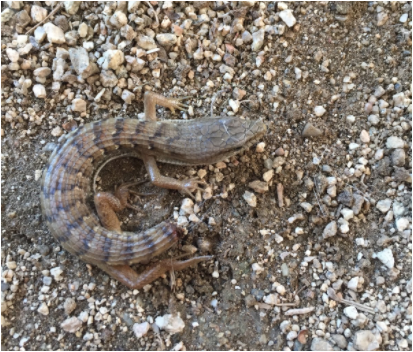New study by NHMLAC Urban Nature Research Center uses community science to demonstrate the challenges and opportunities of city-living for native lizards
Photos contributed by volunteers from across Southern California show that city lizards are at higher risk of losing their tails but decreased risk of tick parasitism, highlighting the value of community science for urban ecology studies

Southern Alligator Lizard photographed immediately after an attack by a cat, during which it dropped its tail. Photograph by Kristin Papoi and Violet Gibbs and contributed to iNaturalist (observation 1733118).
Los Angeles, CA (February 4, 2021) — Animals living in urban areas face many challenges, including changes in habitat, food, and predators—all in addition to dealing with humans. Understanding the ways in which urbanization impacts local species is especially important for conserving native wildlife in urban areas. However, wildlife biologists often have a hard time studying urban-dwelling animals because much of their habitat is on private property, and thereby inaccessible to scientists. Furthermore, many animals are secretive and have low detection rates by even the most-trained professionals. A paper published today in the journal Scientific Reports, demonstrates how scientists are crowdsourcing data from the general public to answer fundamental questions about the threats faced by urban wildlife (specifically, lizards).
Scientists with the Natural History Museums of Los Angeles County’s (NHMLAC) Urban Nature Research Center partnered with community members as a way to more-effectively study urban wildlife. This effort, termed community science by NHMLAC, is also known as citizen science. NHMLAC supports multiple community science initiatives, and the Reptiles and Amphibians of Southern California (RASCals) project, which was initiated in 2013 and hosted on the iNaturalist platform, has generated thousands of observations of urban-dwelling reptiles.
Dr. Greg Pauly, Curator of Herpetology at NHMLAC and senior author on the article was surprised to find that a species deemed “difficult-to-study” turned out to be one of the most-observed on the RASCals project. “This species, the Southern Alligator Lizard (Elgaria multicarinata), is a secretive lizard that is abundant and widespread across most of Southern California,” said Dr. Pauly, ”but spends much of its time hidden under objects or vegetation.” As a result, scientists generally have a hard time studying it, and only a few papers have been published on its ecology.
With this new wealth of community science data, Pauly and Dr. Bree Putman, a research associate at NHMLAC and assistant professor at CSU San Bernardino, set out to understand what challenges this lizard faces in urban areas. From photographs submitted online by the community, Pauly, Putman, and their team were able to determine whether lizards had experienced a tail break, an adaptation to escape a predatory attack. They were also able to count the number of ticks attached to the ear region. “With hundreds of people just submitting a few photographs at a time, we gathered valuable data on predation and parasitism in a secretive animal that would have been near impossible using traditional research methods. It’s an incredible achievement of crowd-sourcing for conservation research” said Putman, the lead author of the study.
The scientists found that urban lizards were more likely to suffer from a broken tail. Adult lizards living in the most urbanized areas, most of which were higher density residential neighborhoods, had a 75–80% probability of having lost their tails, which is more than a 20-percentage point increase compared to adults living in the most natural sites. Putman says that this could be attributed to an increase in attacks from human-companion animals such as outdoor cats and dogs. She also notes that “urban lizards might face additional threats that are absent in natural habitats such as pesky kids, bicycles, cars, and even rolling trash cans! Alligator lizards love to hide under cover objects, and rolling trash cans seem to be a common hiding spot in residential neighborhoods.” Losing the tail has serious consequences, leading to reduced health and reproduction, but it is better than the alternative of being eaten by an attacking predator.
City dwelling, however, isn’t all bad news for these lizards. Urban alligator lizards were less likely to have parasites compared to their rural counterparts. This also could be a possible side effect of human-companion animals, which receive anti-tick medications from their humans. For a tick to complete its life cycle, it needs two hosts, with the first typically being a lizard or small mammal and the second being a larger mammal. Thus, humans might unintentionally release lizards from tick parasitism through caring for their pets, and this might then benefit animals in urban environments.
This research is not only about lizards. “This research continues to highlight the ways in which community science is revolutionizing ecology and conservation research”, says Pauly. “We were able to examine nearly 1700 lizards from San Luis Obispo to San Diego, and from the coast to high in the mountains. We collected this dataset in a matter of weeks, and that was only possible because 424 community scientists uploaded observations of alligator lizards to iNaturalist.”












